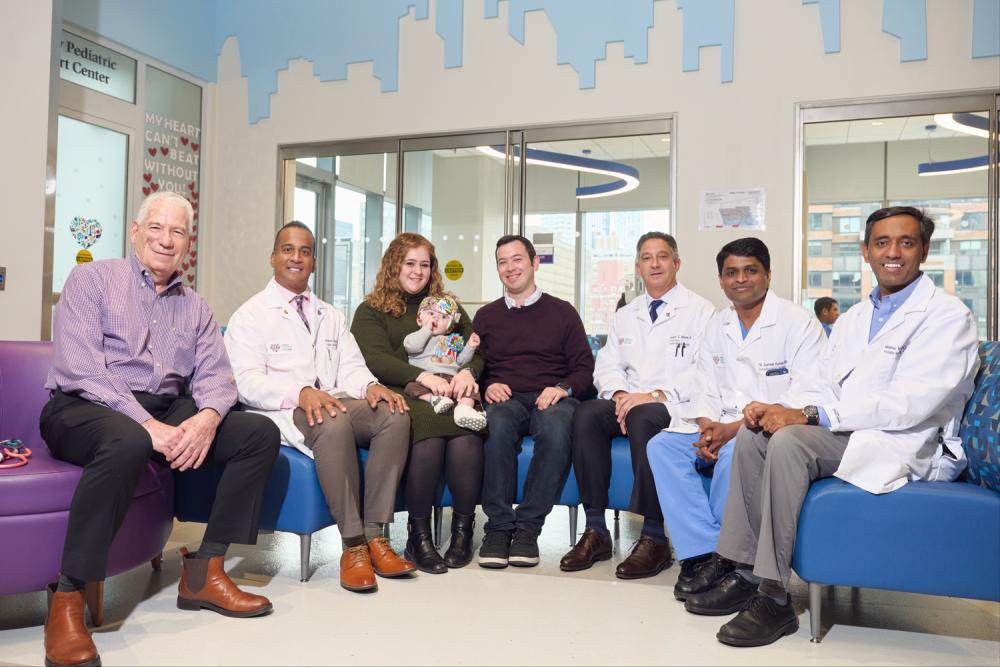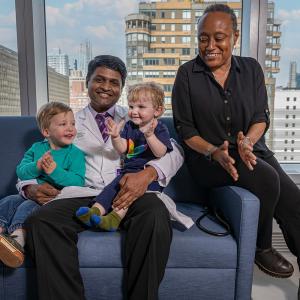
Certified child life specialists including Karissa Fischer, MS, CCLS, were integral parts of Nathaniel's care team, providing emotional support as well as the playtime every baby needs to develop and grow.
Photo: joe carrotta
Henya Grossman was 27 weeks pregnant with her first child when diagnostic scans revealed devastating news: her unborn baby had a severely weakened left ventricle, the heart chamber that pumps oxygenated blood throughout the body. He would likely develop severe heart failure after birth and require a heart transplant to survive.
“I went to the top doctors and hospitals in Israel,” says Grossman, an Israeli native. “But no one had experience treating unborn babies with this rare condition. I was told my baby likely wouldn’t survive. But I wanted to keep my baby and fight for him.”
Her best hope was to go to the United States. Achiau Ludomirsky, MD, a pediatric cardiologist with NYU Langone’s Pediatric Congenital Heart Program, part of Hassenfeld Children’s Hospital at NYU Langone, spoke with Grossman and her husband, Yair Broyer. A plan was hatched: they would travel to NYU Langone for specialty prenatal and pediatric cardiac care, so that ultimately their baby could have a lifesaving heart transplant.
“Dr. Ludomirsky was amazing. I felt like with NYU Langone, I was going to be in the very best hands,” Grossman says.
Advanced Prenatal Monitoring
After arriving in New York City, Grossman began weekly prenatal care appointments with NYU Langone’s maternal–fetal medicine and pediatric cardiology specialists. A fetal echocardiogram confirmed the diagnosis first made by her Israeli doctors: life-threatening dilated cardiomyopathy.
“Undergoing prenatal care with an unborn baby who was so sick felt like going into the unknown,” Grossman says. “But everyone at NYU Langone was so helpful and professional. I was so grateful there was a place like this in the world.”
At 37 weeks into her pregnancy, the first major milestone was accomplished: Grossman gave birth to a baby boy, Nathaniel, on December 6, 2022, weighing 6 pounds, 15 ounces. Nathaniel was placed on Grossman’s chest for a few seconds of bonding time before he was taken to the Congenital Cardiovascular Care Unit at Hassenfeld Children’s Hospital. “I was so happy and relieved that he made it, and that he was crying and that he looked good,” Grossman says.
Nathaniel was alive, but at high risk for complications such as sudden cardiac death. “From our perspective, he was very sick,” says Rakesh Singh, MD, medical director of the Pediatric Heart Failure and Transplant Program. “He would need a heart transplant to survive.”
An Innovative, Lifesaving Strategy
The second major challenge was keeping Nathaniel alive until a donor heart became available. The average waiting time for an infant for a heart transplant in the New York City area is six to nine months.
To bridge that time, a left ventricular assist device (LVAD) called the Berlin Heart could help Nathaniel’s weakened heart move blood through his body. But the Berlin Heart carried an increased risk of bleeding and stroke in infants. Was there a better way? T.K. Susheel Kumar, MD, surgical director of the Pediatric Heart Failure and Transplant Program, proposed a novel plan: to compensate for Nathaniel’s failing left ventricle, use his healthy right ventricle to augment blood flow throughout his body.
“I felt like with NYU Langone, I was going to be in the very best hands.”
—Henya Grossman, Nathaniel's Mom
“Given that Nathaniel’s right heart ventricle was functioning well, and with the known complications of a ventricular assist device in a small baby, we decided to convert him into a single ventricle physiology, using a hybrid strategy,” says Dr. Kumar.
The strategy involved using intravenous medication to keep open the patent ductus arteriosus (PDA)—an extra blood vessel in the heart that naturally closes after birth. Nathaniel would also have pulmonary artery banding, a surgical procedure to place bands on the outside of the pulmonary artery to limit blood flow. This reduces the risk of long-term lung damage.
“The hybrid procedure—keeping the PDA open and pulmonary artery banding—had been performed in patients with other congenital heart defects. We decided to mimic that procedure in Nathaniel even though it wasn’t the standard of care for dilated cardiomyopathy,” Dr. Singh says.
If the procedure didn’t work, they had the Berlin Heart as a backup. Everyone, including Nathaniel’s parents, agreed that the hybrid procedure was worth a try.
Waiting to Beat the Odds
After a few touch and go weeks, Nathaniel stabilized with the PDA procedure and pulmonary artery banding. He was placed on the transplant list, and the wait for a new heart began.
While having the novel therapy, Nathaniel remained on a ventilator under mild sedation under the dedicated and specialized care of the Congenital Cardiovascular Care Unit team. “Our goal was to keep him as awake as possible so he could develop and interact with his family until an infant heart became available,” Dr. Singh says.
Nathaniel’s parents spent their days and nights in the hospital in shifts. “Since Nathaniel’s birth, we never left him alone for more than a few hours,” Grossman says. “The hospital didn’t just take care of Nathaniel medically. The amazing child life specialists also took care of him mentally and developmentally, making his time in the hospital so much better. And the nurses were great. They became our friends and like family.”
As the months wore on, Nathaniel had good and bad days, including a trip to the cardiac catherization lab for a stent procedure to prop open the PDA. “The hardest part of the journey is getting to transplant, and we kept thinking of ways to get there,” Dr. Singh says.
Due to the lack of infant donor hearts, the chance of an infant dying while waiting for a heart transplant is as high as 20 percent, which is higher than that of all other patients awaiting a solid organ transplant. “It felt like we were fighting for every minute of Nathaniel’s life,” Grossman says.
A Donor Heart—Just in Time
After five and a half months in the Congenital Cardiovascular Care Unit, Nathaniel began showing signs of worsening heart failure. “We were having ongoing discussions with the parents about whether we should go ahead with the Berlin Heart,” Dr. Singh says.
Fortunately, on June 16, 2023, a donor heart became available, and Nathaniel had lifesaving heart transplant surgery. A team of doctors, including Dr. Kumar and Ralph S. Mosca, MD, co-director of the Pediatric Congenital Heart Program, performed a heart transplant after rebuilding Nathaniel’s pulmonary arteries. “The donor heart worked perfectly from the moment it started beating,” Dr. Kumar says.
Two months later, Nathaniel’s parents, who have moved to New York City, took their son home for the first time. Nathaniel has been receiving outpatient occupational, physical, speech therapy, and other pediatric rehabilitation services through Rusk Rehabilitation to catch up on developmental milestones, such as crawling, standing, and eating by mouth.
Nathaniel is expected to live a full life. “Infants who make it to transplant have a greater than 50 percent chance of doing well with the same heart 25 years later,” Dr. Singh says. “Children can go to school with their peers, in regular classes. They can play sports, go to college, get married and have kids, all the things parents want for their kids.”
On December 6, 2023, Nathaniel celebrated his first birthday with balloons and video calls with his extended family in Israel. “I have the most amazing baby in the world, thanks to God and the amazing medical team at NYU Langone that he sent to us, who saved his life,” Grossman says. “I can’t thank them enough for helping me have my miracle child.”
Read and watch more from People and CBS Newspath.


